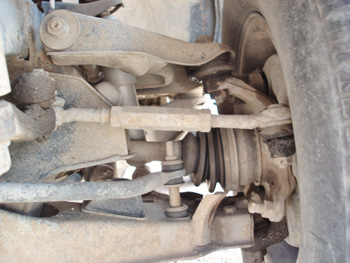Any good alignment technician knows that steering linkage is the most critical part of the steering system because worn linkage can not only cause excessive tire wear, it can also become an important safety and liability issue. If, for example, a tie rod end or tie rod adjusting sleeve breaks, the driver will immediately lose steering control of his vehicle. Consequently, it’s important for all parts and service professionals to emphasize safety when selling steering linkage parts.
 Linkage Configurations
Linkage Configurations
Steering linkages are designed in two general configurations, parallelogram and rack and pinon. The conventional parallelogram linkage has been with us since independent front suspension came into popular use during the late 1930s. Because modern right and left-hand suspensions travel independently of each other, the tie rods must pivot through approximately the same vertical arc as the front lower control arms.
Independent suspension geometry therefore requires an inner and outer tie rod end mounted at
approximately the same pivot points as the front lower control arm. The right- and left-side tie rods are connected to each other by a center link, which is also mounted to the Pitman arm on the steering gear and the idler arm on the passenger side of the vehicle. In the straight-ahead position, the Pitman arm, center link and idler arm form a rectangle. When the vehicle is turned, they form a parallelogram, which gives this particular design its name.
Rack and pinion steering is much simpler in design, since the steering gear or rack is mounted directly between the inner and outer tie rod ends. The inner tie rod end is a ball-and-socket design, which forms the body of the tie rod and which is threaded to the outer tie rod end. In most cases, rack and pinion steering gears are sold as “long racks,” which include the inner tie rod ends and boots. Rack and pinion steering is currently the most predominate of the two steering linkage systems.
Parallelogram Failure Patterns
Parallelogram steering linkages have many wear points that affect the total toe angle of the front tires. The toe angle of the front wheels is easy to remember if you look at your own feet: toes in = “toe in.” toes out = “toe out.” The Pitman arm steers the vehicle by transmitting the thrust from the steering wheel, through the steering gear, to the steering linkage, and then to the front wheels. The symptom of a worn Pitman arm or steering gear is excessive play in the steering wheel. In contrast, the idler arm’s job is to simply suspend the passenger side steering linkage from the frame. The primary symptom of a worn idler arm is wear on the outer edge of the passenger side front tire.
Wear in any of the four tie rod ends results in excessive variation between toe-in and toe-out, both of which cause tire wear and steering wander. Since modern toe angles are measured in thousandths of an inch, minor wear in each of the four tie rod ends can cause critical variations in toe angle. Remember, too, that because tie rod ends are preloaded to compensate for normal wear, the tie rod end should be discarded if it feels loose. Last, it’s extremely important to remind your retail customers that straightening a steering linkage part will create stress risers in the metal that will eventually fracture and cause a catastrophic component failure.
From The Service Bay
Some alignment technicians prefer permanently lubricated steering linkage parts while others prefer parts equipped with grease fittings. When replacing a tie rod assembly that uses a stamped-steel adjusting sleeve, it’s advisable for convenience and for safety’s sake to replace the sleeve along with the tire rod ends. And because they’re reputation is riding on your parts, most professional technicians will insist on premium-grade steering linkage components.







